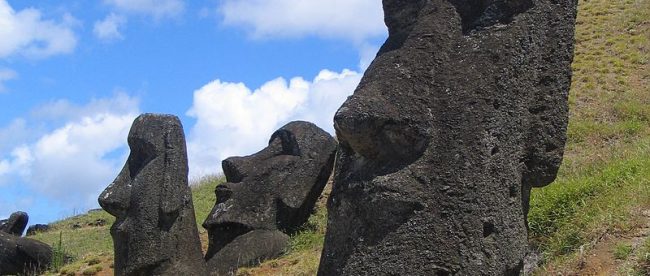The Problem With Invisible Stone Boogers

As the saying goes: You can pick your friends, you can pick your nose, but you can’t pick your friend’s nose.
That’s decent advice (you probably shouldn’t pick your nose). But it’s also incomplete. You also shouldn’t pick the noses of non-human things either, even if those noses are very large and don’t even have any boogers. It’s bad for humanity as a whole, it turns out — virtual nose-picking of that sort is causing harm to our collective history and culture.
Here’s why, in picture form:

Those huge stone heads are the famous feature of Easter Island, a small Pacific Ocean territory now controlled by Chile. There are more than 1,000 such statutes on the tiny island — and they’ve been there for a long, long time. Originally created perhaps a millennium ago, the statues, known as moai, have survived the test of time. But now, a new risk has appeared: nose-picking Instagrammers.
UCLA archaeologist Jo Anne Van Tilburg would know. She’s been studying the island since her days as a grad student in the early 1980s and is now the director of the Easter Island Statue Project at the university. When she first came to Easter Island nearly forty years ago, the remote location alone was enough to keep most tourists away; only about 2,500 people visited each year. But that’s changed. Easter Island is a great place to visit if you’re seeking an exotic vacation — and exotic vacation photos. Easter Island now sees upward of 150,000 visitors a year. And it’s unclear if the moai can handle the foot traffic.
While 150,000 visitors is hardly a lot for most tourist attractions, Easter Island, Van Tilburg told the UCLA press, simply isn’t set up for it — “on an island where electricity is provided by a generator, water is precious and depleted, and all the infrastructure is stressed, 150,000 is a mob,” And the people visiting aren’t there just to look — many also decide to climb the heads, despite not being allowed to do so. The UCLA press continued: “some travelers [ . . .] ignore the rules and climb on the moai, trample preserved spaces and sit on top of graves all in service of getting a photo of themselves picking the nose of an ancient artifact, Van Tilburg said.” Not only is that disrespectful to the native population, but it also puts the stone giants and the surrounding ecosystem at risk.
Van Tilburg isn’t suggesting that people not visit the island, though; she just advocates for tourists to be more respectful of both the statutes and the native community. She told CBS’ 60 Minutes that the moai are made of a softer type of stone (called “tuff”) which is already subject to erosion from the sun, wind, and rain — she likened the rain-driven erosion to that of “sugar cubes.” Unless we develop a way to preserve the moai against the elements, they’re likely to slowly disappear over time — and tourists should be careful to not exacerbate that problem.
Bonus fact: The moai aren’t the only cultural touchstones (pardon the pun) at risk from the self-seekers either; as the New York Post notes, “in the Netherlands, tulip growers had to plead with visitors to stop trampling the flowers in search of the perfect selfie, which causes thousands of dollars of damage.” (In that case, per the Post, “the Dutch tourism board launched a campaign for ‘tulip-friendly selfies’ with the hashtag #watchyourfeet.)
Double bonus!: The moai aren’t stone heads; dig deep enough, and you’ll find they have bodies, too. But you literally have to dig, as over the centuries, the bodies have been swallowed by the earth. Recent efforts have excavated some of the bodies to a degree, as seen here.
From the Archives: The Spaceship Graveyard: Another man-made curiosity, one not too far from Easter Island (relatively speaking).
